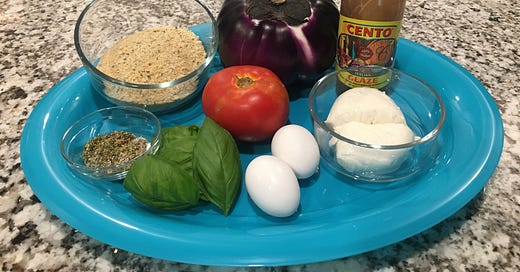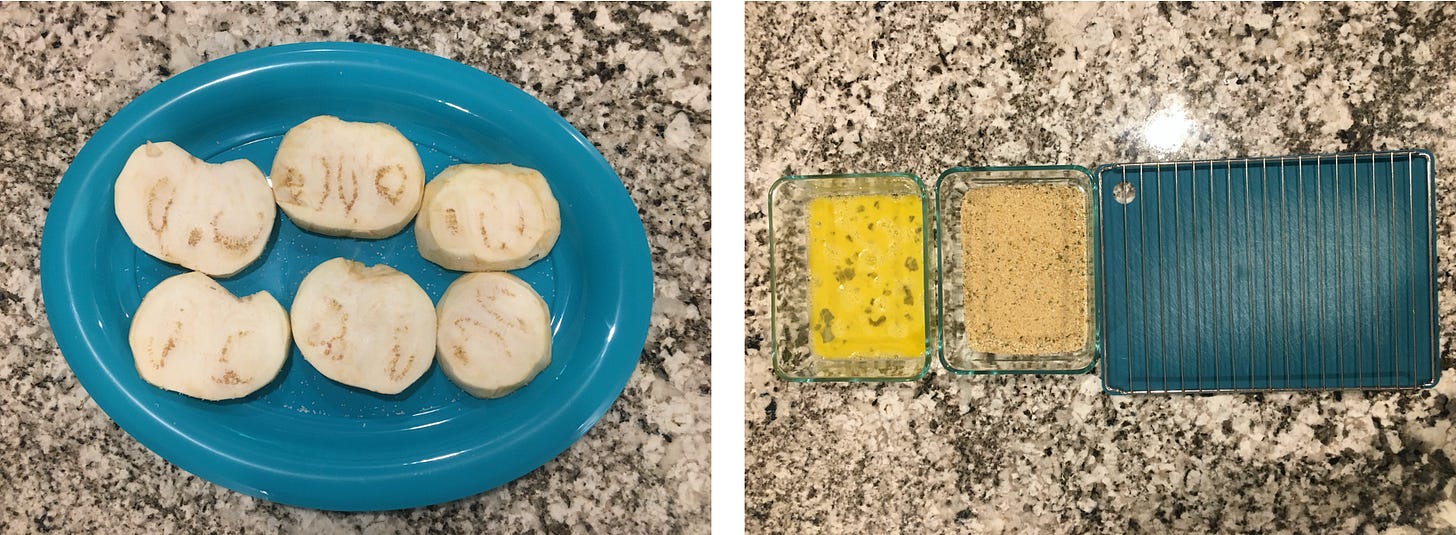Let's Eat: Easy Eggplant Stack
A round and plump Sicilian eggplant takes center stage.
So, once I got home last week with my farm stand haul, I knew I needed to figure out what I was going to make with all the good stuff I picked up. The Sicilian eggplant was plump and firm, and I knew I wanted to use that as a centerpiece. One thing I like to make with eggplant is baba ghanoush, which is an easy and delicious middle eastern dip/side dish that can be made with minimal, but highly customizable ingredients. It does require you to roast and then blend the eggplant, and I didn’t want to blend this one because it was so round and glorious and screaming out to be somehow prepared in slices.
I figured I had three solid choices: eggplant parmigiana, eggplant lasagna, or plain old fried eggplant, which is one of the simplest and most delicious ways to prepare it. After taking another look at what I had to work with, I decided to do something of a combo of the three and make an eggplant stack, which layers crispy fried eggplant slices, tomato sauce, mozzarella cheese, and basil. Having picked up the three main components: the eggplant, the field tomato, and fresh mozzarella at the farm stand, all I needed was the basil, which I happily had growing outside (actually the basil was the only successful thing I had growing this year, but that’s a story for another time). Add in a couple of other standard pantry items, and I was ready to go.
Now, just a quick note. I am not a professional recipe writer. I am a fairly ok home cook who loves to experiment and try different things. Over the years, I find that I cook more intuitively and don’t always measure everything. I am going to be as deliberate as I can about amounts and measurements of ingredients, but I am not always following a recipe, I am making it up as I go along. Maybe that’s good, maybe not. I hope you can roll with it. If not, let me know in comments. :)
Ingredients:
· 1 large Sicilian eggplant (or globe/American Variety if you can’t find Sicilian)
· 2 eggs
· Seasoned breadcrumbs (start with 1 cup and add more as needed)
· 1 large, field, hot-house, field, or heirloom tomato (try to match the circumference of the tomato with the eggplant if you can)
· 6-10 fresh basil leaves
· 1 large or 2 small fresh mozzarella balls (fresh mozzarella works better in this dish as opposed to block mozzarella)
· Seasoning mix for tomatoes (I used salt, pepper, dried oregano, and garlic powder)
· Balsamic glaze for drizzling (easy to find in supermarkets in the vinegar section)
· Canola or vegetable oil for pan-frying (enough to fill about a quarter of an inch in the pan)
Tools:
· 2 large serving plates or platters (one for the salted eggplant, one for serving)
· 2 glass (or plastic) containers for the egg and breadcrumbs
· 2 wire racks
· Cutting board (to catch escaped crumbs)
· Frying or sauté pan
· Tongs or spatula
· Fork to scramble eggs
Steps
1. Peel and slice the eggplant into roughly ½ inch rounds and place them on a dish or on a clean towel.
2. Sprinkle a bit of salt* on each side and let them sit for 15-30 minutes.
3. While the eggplant salt, set up your breading station. Crack and scramble the eggs in one; place the breadcrumbs in the other. Keep the eggs on the left and the breadcrumbs on the right. Place the wire rack on the cutting board to the right of the breadcrumbs.
4. Pat the eggplant dry (don’t rinse under water).
5. Dip the eggplant slices into the egg and then into the breadcrumbs, ensuring all the edges are covered. Try and keep on hand dry while you bread (probably your right hand) to cut down on messiness and waste. Place the breaded slices on the rack. Repeat until all slices are breaded.
6. Pour the oil into your pan to give yourself about 1/4-inch of depth.
7. Heat the oil over medium to high heat** and place the second rack on your counter close to the pan. You’ll know the oil is ready if you drop in a couple of breadcrumbs and they begin to sizzle.
8. When the oil is heated, carefully place two of three eggplant slices into the pan. Be careful not to splatter the oil. Don’t crowd them in the pan.
9. After about three minutes, check to see if the eggplant is browning. You want a deep brown and crispy texture. Once they look good, use your tongs or spatula to carefully turn the eggplant to cook the other side. Place on the wire rack when they are done.
10. Finish cooking all of the slices. You can lightly salt them again at this stage if you’d like. Let them rest on the rack.
11. Using the same pan***, lower the heat a bit and repeat the sautéing process with the tomatoes. The thicker the slice of tomato, the longer you will need to sauté. You can let them caramelize a bit in the pan or cook them just until they are warm in the center. When they are done to your liking, turn off the heat and leave them in the pan. If you are doing more than one batch of tomatoes, place the cooked slices on a flat dish while you cook the rest.
12. Slice the mozzarella cheese into rounds
13. Snip your basil leave from the stem. You can also chiffonade the basil.
14. Begin to (carefully) create your stack on the second serving plate or platter. Alternate eggplant-tomato-cheese-basil layers, with the top layer being an eggplant slice.
15. Drizzle the balsamic glaze over top and garnish with basil leaves if you’d like.
16. Serve immediately and enjoy!
* The salting step is designed to pull any bitterness out of the eggplant before cooking it. Some people skip this step.
** Always be sure to be careful when cooking with hot oil.
*** The eggplant will soak up some of the oil in the pan. You probably won’t need to add more oil to cook the tomatoes, but if you do, add just a tablespoon at a time.
A couple of notes:
· If you have extra fried eggplant slices, they are delicious on their own.
· If you don’t want to sauté the tomatoes, you can use a marinara sauce, but you might lose the full layering effect.
· Go easy on the glaze. Too much glaze will add too much sweetness. Using just the right amount really complements the heartiness of the eggplant and complements the natural sweetness of the tomatoes.
This dish makes for a great appetizer for a group or a non-meat dinner or lunch main. You can use virtually any type of eggplant, but keep in mind that the large and round Sicilian and standard globe varieties like the Italian lend themselves to slices of larger circumferences. Japanese and Chinese varieties are longer and smaller and may not yield as many slices as you would like. The good news about this recipe is that it is variable, and you can try different eggplants and tomatoes.
Bon appétit!
© 2023 Kim Selby. All rights reserved.
All photography © Kim Selby unless otherwise credited.








